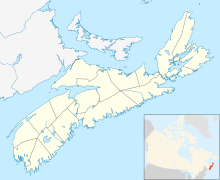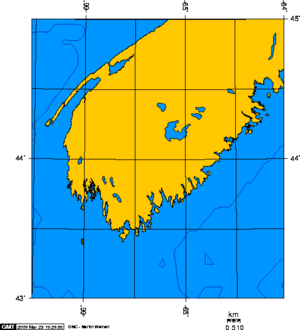Cape Sable Island facts for kids
Cape Sable Island, also known as Cape Island, is a small Canadian island. It is the southernmost point of the Nova Scotia peninsula. Sometimes, people confuse it with Sable Island. Long ago, the Argyle, Nova Scotia area was called Cape Sable. It was much larger than just the island we know today. It stretched from Cape Negro to Chebogue.
The island is in Shelburne County, south of Barrington Head. A narrow strait called Barrington Passage separates it from the mainland. But since 1949, a causeway has connected the island to the mainland. The biggest town on the island is Clark's Harbour. Other smaller communities are listed below. At the very southern tip of the island is Cape Sable.
Contents
History of Cape Sable Island
The Mi'kmaq people first lived on Cape Sable Island. They called it Kespoogwitk, meaning "land's end." Later, explorers from Portugal found the island. They named it Beusablom, which means "Sandy Bay."
French Settlement on Cape Sable Island
In 1620, French settlers called Acadians moved from Port Royal, Nova Scotia. They settled at Cape Sable and Cape Negro, Nova Scotia. The French governor of Acadia, Charles de la Tour, named it Cap de Sable, meaning Sandy Cape.
La Tour built a strong trading post at Cap de Sable in 1623. He called it Fort Lomeron. This fort was later renamed Fort La Tour. He traded many furs with the Mi'kmaq people and farmed the land.
During the Anglo-French War (1627–1629), the British took some French lands. By 1629, Cape Sable was almost the only French area left in North America. There was a battle at Fort St. Louis on the island in 1629. Charles de la Tour fought against those who supported the Scottish. He had to retreat.
After this, La Tour asked the King of France for help. In 1631, he was made a high-ranking officer in Acadia. But by 1641, La Tour lost Cape Sable Island and other areas to another French governor, Charles de Menou d'Aulnay. La Tour later retired to Cape Sable with his wife and died there in 1666.
Pirates and Treaties
During Dummer's War, many New England fishing boats were attacked. Cape Sable was a busy spot for fishing. This made it a target for pirates during the Golden Age of Piracy. Pirates like Ned Low and John Phillips attacked fishing boats near Cape Sable. Phillips even died off the Cape in 1723.
In 1725, the British signed a treaty with the Mi'kmaq people of Cape Sable. This agreement allowed the Mi'kmaq to hunt and fish on their lands. However, this right has often been argued about by authorities.
French and Indian War and Acadians
The British took over Acadia in 1710. For the next 45 years, the Acadians refused to promise loyalty to Britain. They often helped the French military and supplied the French forts. Acadians and Mi'kmaq from Cape Sable Island attacked British settlements like Lunenburg many times.
During the French and Indian War, the British decided to remove the Acadians. This was to stop them from helping the French. In 1756, British troops raided a settlement near Port La Tour. They captured 72 Acadians.
In 1758, the British launched more attacks against the Acadians. Major Henry Fletcher led soldiers to Cape Sable Island. They surrounded the area. One hundred Acadians and a priest surrendered. About 130 Acadians and seven Mi'kmaq escaped. The captured Acadians were sent to Georges Island in Halifax.
Later in 1758, more Acadians were deported from the area. Women and children were sent to Georges Island. The men were made to destroy their village before being sent to Halifax. In 1759, the remaining 151 Acadians were also captured and sent to Georges Island.
New England Planters Arrive
After the Acadians were removed in the 1750s, new settlers came to the island. These were the New England Planters from Cape Cod and Nantucket Island. They knew the waters off Nova Scotia well.
Many New Englanders took an offer of land. They could get 50 acres of land if they moved to these empty areas in Atlantic Canada. Cape Sable Island was a well-known fishing spot. So, in 1760, many moved north to start a new life.
The Cape Sable settlement quickly became a vital fishing base. It still is today. The island is famous as the birthplace of the Cape Islander fishing boat. This motor fishing boat first appeared around 1905. For many years, ferries provided transport to the island. A causeway for cars and people opened on August 5, 1949. Today, catching lobster is the island's biggest industry.
American Revolution
Raid on Cape Sable Island (1778)
During the American Revolution, there was a raid on Cape Sable Island. On September 4, 1778, British soldiers arrived. American privateers (private ships allowed to attack enemy ships) were threatening the island. The British soldiers surprised the privateer ship at night and destroyed it. The British officer in charge, Captain Ranald MacKinnon, was highly praised for his brave actions.
Communities of Cape Sable Island
Here are the communities located on Cape Sable Island:
- Cape Sable Island
- Centreville
- Clam Point
- Clark's Harbour
- Lower Clarks Harbour
- Newellton
- North East Point
- South Side
- Stoney Island
- The Hawk
- West Head
Shipwrecks Near Cape Sable
Cape Sable is in a very busy fishing area. It was also an important landmark for ships during the time of sailing ships. This busy traffic led to many shipwrecks. Famous wrecks include the SS Hungarian in 1862 and the schooner Codseeker in 1877.
Climate of Cape Sable Island
Cape Sable Island has an oceanic climate. This means it's affected a lot by the ocean. The surrounding waters make summers cooler. Winters are milder, with less snow than other parts of Nova Scotia. Summer temperatures are quite low for this part of the world.
Winters are wet and windy. But they are warm compared to other places in Atlantic Canada. Snowfall is moderate. However, it gets less snow than cities like Sydney, Nova Scotia or St. John's, Newfoundland. Summers on Cape Sable Island are cool. The weather is more stable than in winter.
Because of the cool ocean, summer thunderstorms are rare. But low clouds and fog are common. The strong ocean influence also means the seasons change slowly. On average, February is the coldest month. September is the warmest, just a bit warmer than August. October is slightly warmer than June.
The island is in the path of Nor'easter storms. These storms are strongest in winter. This means December and January are usually the wettest months. Tropical storms, like hurricanes, can also happen. They usually come from the south or southwest. The biggest risk is in September and October.
Cape Sable Island often has thick fog. Over the years, the island's storms and its location near shipping routes have caused many shipwrecks. The worst was the SS Hungarian in February 1860. Over 200 lives were lost. A lighthouse was built at the tip of Cape Sable the next year.
| Climate data for Cape Sable Island (1948-1986) | |||||||||||||
|---|---|---|---|---|---|---|---|---|---|---|---|---|---|
| Month | Jan | Feb | Mar | Apr | May | Jun | Jul | Aug | Sep | Oct | Nov | Dec | Year |
| Record high °C (°F) | 12.0 (53.6) |
12.0 (53.6) |
14.0 (57.2) |
16.0 (60.8) |
18.9 (66.0) |
22.8 (73.0) |
24.0 (75.2) |
24.0 (75.2) |
23.9 (75.0) |
22.0 (71.6) |
17.2 (63.0) |
13.9 (57.0) |
24.0 (75.2) |
| Mean daily maximum °C (°F) | 1.4 (34.5) |
0.7 (33.3) |
3.0 (37.4) |
5.7 (42.3) |
8.8 (47.8) |
12.0 (53.6) |
13.8 (56.8) |
14.9 (58.8) |
15.1 (59.2) |
12.3 (54.1) |
8.7 (47.7) |
4.6 (40.3) |
8.4 (47.1) |
| Daily mean °C (°F) | −1.6 (29.1) |
−2.1 (28.2) |
0.6 (33.1) |
3.6 (38.5) |
6.8 (44.2) |
9.7 (49.5) |
11.3 (52.3) |
12.4 (54.3) |
12.7 (54.9) |
10.0 (50.0) |
6.2 (43.2) |
1.4 (34.5) |
5.9 (42.6) |
| Mean daily minimum °C (°F) | −4.8 (23.4) |
−5.0 (23.0) |
−1.9 (28.6) |
1.4 (34.5) |
4.6 (40.3) |
7.3 (45.1) |
8.7 (47.7) |
9.9 (49.8) |
10.3 (50.5) |
7.6 (45.7) |
3.6 (38.5) |
−1.8 (28.8) |
3.3 (37.9) |
| Record low °C (°F) | −17.2 (1.0) |
−18.3 (−0.9) |
−14.5 (5.9) |
−6.7 (19.9) |
−1.1 (30.0) |
2.8 (37.0) |
5.0 (41.0) |
5.6 (42.1) |
0.6 (33.1) |
−3.0 (26.6) |
−7.8 (18.0) |
−19.0 (−2.2) |
−19.0 (−2.2) |
| Average precipitation mm (inches) | 140.4 (5.53) |
112.7 (4.44) |
104.8 (4.13) |
98.7 (3.89) |
86.4 (3.40) |
76.2 (3.00) |
68.3 (2.69) |
104.6 (4.12) |
73.4 (2.89) |
89.8 (3.54) |
122.2 (4.81) |
139.6 (5.50) |
1,217.1 (47.92) |
| Average rainfall mm (inches) | 86.5 (3.41) |
71.5 (2.81) |
83.5 (3.29) |
94.6 (3.72) |
86.1 (3.39) |
76.2 (3.00) |
68.3 (2.69) |
104.6 (4.12) |
73.4 (2.89) |
89.1 (3.51) |
120.8 (4.76) |
113.3 (4.46) |
1,067.9 (42.04) |
| Average snowfall cm (inches) | 53.9 (21.2) |
41.2 (16.2) |
21.2 (8.3) |
4.2 (1.7) |
0.3 (0.1) |
0 (0) |
0 (0) |
0 (0) |
0 (0) |
0.7 (0.3) |
1.3 (0.5) |
26.3 (10.4) |
149.0 (58.7) |
| Average precipitation days (≥ 0.2 mm) | 17 | 13 | 12 | 11 | 10 | 10 | 9 | 9 | 8 | 10 | 13 | 16 | 138 |
| Average rainy days (≥ 0.2 mm) | 8 | 6 | 9 | 10 | 10 | 10 | 9 | 9 | 8 | 10 | 13 | 11 | 112 |
| Average snowy days (≥ 0.2 cm) | 11 | 8 | 5 | 1 | 0 | 0 | 0 | 0 | 0 | 0 | 0 | 6 | 32 |
| Source: Environment Canada | |||||||||||||
Bird Watching on Cape Sable Island
The ocean surrounds Cape Sable Island. This gives it a cool summer climate and milder winters. The island is a great place for bird watching. It is an important stop for migrating birds. Birds like the Atlantic brant and piping plover rest here.
This special climate, along with its tidal marshes and location, makes it an Important Bird Area. Every March and April, thousands of brant geese fly by. They spend the day eating in the marshes. Then, at dusk, they put on a spectacular show as they fly to the Atlantic. They spend the night floating in the ocean east of the island.



